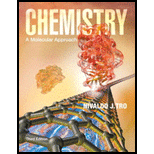
Consider the two reactions:
a. Why is the activation barrier for the first reaction so much higher than that for the second?
b. The frequency factors for these two reactions are very close to each other in value. Assuming that they are the same, calculate the ratio of the reaction rate constants for these two reactions at 25 °C.
Want to see the full answer?
Check out a sample textbook solution
Chapter 13 Solutions
Chemistry: A Molecular Approach
- Bacteria cause milk to go sour by generating lactic acid. Devise an experiment that could measure the activation energy for the production of lactic acid by bacteria in milk. Describe how your experiment will provide the information you need to determine this value. What assumptions must be made about this reaction?arrow_forwardExperiments during a recent summer on a number of fireflies (small beetles, Lampyridaes photinus) showed that the average interval between flashes of individual insects was 16.3 s at 21.0C and 13.0 sat 27.8C. a. What is the apparent activation energy of the reaction that controls the flashing? b. What would be the average interval between flashes of an individual firefly at 30.0C? c. Compare the observed intervals and the one you calculated in part b to the rule of thumb that the Celsius temperature is 54 minus twice the interval between flashes.arrow_forwardThe activation energy for the reaction NO2(g)+CO(g)NO(g)+CO2(g) is 125 kJ/mol, and E for the reaction is 216 kJ/mol. What is the activation energy for the reverse reaction [NO(g) + CO2(g) + NO2(g) + CO(g)]?arrow_forward
- Based on the diagrams in Exercise 12.83, which of the reactions has the fastest rate? Which has the slowest rate?arrow_forwardConsider the hypothetical reaction A2(g) + B2(g) 2AB(g), where the rate law is: [A2]t=k[A2][B2] The value of the rate constant at 302C is 2.45 104 L/mol s, and at 508C the rate constant is 0.891 L/mol s. What is the activation energy for this reaction? What is the value of the rate constant for this reaction at 375C?arrow_forwardCompare the functions of homogeneous and heterogeneous catalysts.arrow_forward
- Based on the diagram in Exercise 12.83, which of the reactions has the fastest rate? Which has the slowest rate?arrow_forwardOne of the concerns about the use of Freons is that they will migrate to the upper atmosphere, where chlorine atoms can be generated by the following reaction: CCl2F2(g)Freon-12hvCF2Cl(g)+Cl(g) Chlorine atoms can act as a catalyst for the destruction of ozone. The activation energy for the reaction Cl(g) + O3(g) ClO(g) + O2(g) Is 2.1 kJ/mol. Which is the more effective catalyst for the destruction of ozone, Cl or NO? (See Exercise 75.)arrow_forwardThe following rate constants were obtained in an experiment in which the decomposition of gaseous N2O; was studied as a function of temperature. The products were NO, and NO,. Temperature (K) 3.5 x 10_i 298 2.2 x 10"4 308 6.8 X IO-4 318 3.1 x 10 1 328 Determine Etfor this reaction in kj/mol.arrow_forward
 ChemistryChemistryISBN:9781305957404Author:Steven S. Zumdahl, Susan A. Zumdahl, Donald J. DeCostePublisher:Cengage Learning
ChemistryChemistryISBN:9781305957404Author:Steven S. Zumdahl, Susan A. Zumdahl, Donald J. DeCostePublisher:Cengage Learning
 Chemistry: An Atoms First ApproachChemistryISBN:9781305079243Author:Steven S. Zumdahl, Susan A. ZumdahlPublisher:Cengage Learning
Chemistry: An Atoms First ApproachChemistryISBN:9781305079243Author:Steven S. Zumdahl, Susan A. ZumdahlPublisher:Cengage Learning Chemistry: Principles and PracticeChemistryISBN:9780534420123Author:Daniel L. Reger, Scott R. Goode, David W. Ball, Edward MercerPublisher:Cengage Learning
Chemistry: Principles and PracticeChemistryISBN:9780534420123Author:Daniel L. Reger, Scott R. Goode, David W. Ball, Edward MercerPublisher:Cengage Learning Chemistry for Engineering StudentsChemistryISBN:9781337398909Author:Lawrence S. Brown, Tom HolmePublisher:Cengage Learning
Chemistry for Engineering StudentsChemistryISBN:9781337398909Author:Lawrence S. Brown, Tom HolmePublisher:Cengage Learning Chemistry by OpenStax (2015-05-04)ChemistryISBN:9781938168390Author:Klaus Theopold, Richard H Langley, Paul Flowers, William R. Robinson, Mark BlaserPublisher:OpenStax
Chemistry by OpenStax (2015-05-04)ChemistryISBN:9781938168390Author:Klaus Theopold, Richard H Langley, Paul Flowers, William R. Robinson, Mark BlaserPublisher:OpenStax





